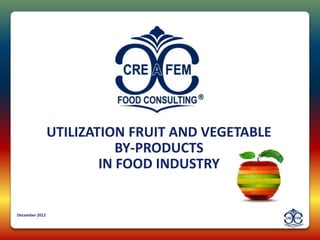
Creafem food consulting ppt 2
- 1. UTILIZATION FRUIT AND VEGETABLE BY-PRODUCTS IN FOOD INDUSTRY December 2012
- 2. 2050’s the world population will climb up to approximately 9,3 billion ! December 2012
- 3. Production volumes of fruit and vegetable, per region (million tonnes) 700 600 500 400 300 200 100 0 Europe North Industrialized Asia Subsahara Africa North Africa, West & South and Southeast Latin America America, Oceania Central Asia Asia FAO Statistical Yearbook 2009 December 2012
- 4. Roughly one-third of the edible parts of food produced for human consumption, gets lost or wasted globally, which is about 1.3 billion ton per year ! December 2012
- 5. The food industry must without any further delay adopt and implement the self- subsistency economy in order to preserve and maintain the rapidly consuming sources of the world. The goal of this policy is to identify and procure the means of production adequate for satisfying the needs of all human beings without giving any harm to our biosphere. December 2012
- 6. To put it in other words, it seems no more possible to invent or discover new raw materials, and inadequacy of the existing raw materials has become a problem.That is why we are obliged to minimize the process, storage and marketing wastes in food industry without further delay. December 2012
- 7. Every kind of fruit or vegetable has got by- products and they are potantial to new product sources before go to bins! December 2012
- 9. For example, zest and albedo are equal to about 33% of the raw material in citrus fruits. Citrus fruit peels may be used in food industry after various processes and treatments. For instance, they are used in paste and cake production, jam production, and production of fruit aroma, fruit extract or pectin production. December 2012
- 10. Another peel is equal to about 12 % of the raw material in apple. Peel of apple is using to produce pectin like lemon peel. December 2012
- 11. Broccoli sales in the market with whole body but usually using 25% of the body in to frozen industry or fresh to home consumption. The rest of 75% broccoli stems C vitamin content within reach to 186 mg/100 g. However orange C vitamin content is 50 mg/100 g. Stem of broccoli can be pass drying process and after it can be use instant soup product. December 2012
- 12. Example of by-products and valorization December 2012
- 13. Example of by-products and valorization December 2012
- 14. Example of by-products and valorization December 2012
- 15. Example of by-products and valorization December 2012
- 16. References: 1) “Utilization of Food By-products In The Food Industry” by Muge Debrun. The Fifth International Congress On Food Industry-New Aspects On Food Processing 1995. 2) Global Food Losses and Food Waste: Save Food at Interpack 2011 Düsseldorf, Germany, by J. Gustavsson, C. Cederberg, U. Sonesson (SIK Sweden) et R. van Otterdijk, A. Meybeck (FAO Italy). 3) FAO Statistical Yearbook 2009. December 2012
